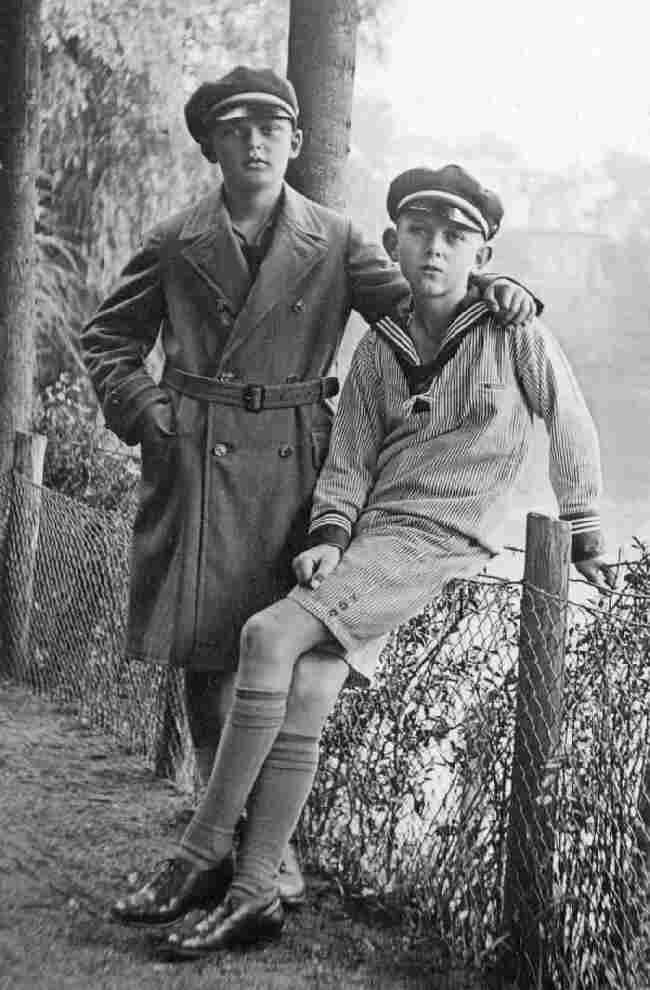
German Inclemate Weather Clothing: Cold Weather--Coats

Figure 1.-- Here we see two brothers who look to be twins. Presumably they both wear sailor suits. The gaberdine coat was worn for both cold weather and rain. This must have been a rainly day as the pgotograph wa taken in July during 1928. Image courtesy of the PB collection.
|
|
The weather can get quite cold in Germany during the winter. Thus we see boys wearing a variety of heavy cold-weather coats. It was more important to dress warmly becuse himes and schools were not as well heated as they are today. Central heating only became common after World War II with the German Economic Miracle. We see German boys wearing a variety of different coats. In the early 20th century they were often worn with knee pants or short pants. We note different styles of overcoats like the boy here wears. We also notice trench coat style gaberdine overcoats like the ones commonly worn by British school boys. There were both single and double-breasted styles. There were also coats for younger boys. The popularity of the different styles have varied overtime.
The weather can get quite cold in Germany durng the winter. Thus we see boys wearing a variety of heavy cold-weather coats and jackets to keep warm in the cold weather. Coats and jackets are sometiumes used interchangeably. For organizational convenience we use coat to mean the longer styles o outerwear and jacket to mean the shorter styles.
German boys had to have a coat or jacket of some time during the inter. There were several different coat styles, both full-length coats and shorter cut jackets. The various styles changed in popularity over time. We do not know a great deal about 19th century times. But we have quite a bit of information on 20th cntury styles. We note different styles of overcoats like the boy here wears. We also notice trench coat style gaberdine overcoats like the ones commonly worn by British school boys. There were both single and double-breasted styles. We also nitioce jackets which became increasingly popular as the 20th century progressed. Some jackets were done like naval pea coats. And we see coats dine like Bavarian (Alpine) jeckets. This was a destinctive German style. There were also a vatiety of coats for younger boys. We see ski jackets in the late-20th century.
Accompanying Clothes
In the early 20th century they were often worn with kneepants or short pants, even in cold weather. Bits very commnly wore knee pants and short pants even during the winter. Thus many boys photographed during the winter in coats were wearing knee pants and short pants, Boys at the time usually wore long stockings or knee socks. Older boys might wear knickers. After World War II by the 1960s, long pants were becoming more common, especially during cold winter weather.
Chronology
The popularity of the different types of outerwear and styles have varied overtime. We have very little historical information. We have some limited information on the 19th century, mostly from the second half of the century when photographic images become available. We have very detailed on the 20th century when we not only have stuidio portraits, but large numbers of snapshots. We notice reefer jackets becoming popular when sailor suits began to beco,e an important style in the late-19th century. We also notice overcoats, donr\e in both light-weight and heavy material. We notice overcoats through the World War II era, but after bthe War we see bmostly njackets. They might be done for ccold weaher wear, but were cut just below the waisline, unlike overcoats which moght be done at knee length or just below the knee. One od the boys here wears a good example (figure 1).
Age
We are not entirely sure, but it seems to us that overcoats were mot commonly worn by ipper-class and middle-class boys. They seem less common for working-class boys. Working-class boys more commonly various types of jackets. We see boys who look to come from affluent families wearing overcoats with classical styling. These same styles were widely worn throughout Europe and in North America (the United Sttes and Canada). Double-breasted overcoats seem particularly popular for the younger children from affluent families.
We do not have a lot of German coat gender information yet. We see boys and girls wearing both similar coats and different styles. Our preliminary assessment is that girls more commonly wore overcoats than boys. This was probably because boys were more active than boys, And overcoats were a more restictive garment than jackets. We also notice differences in colors. Boys commonly wore blue or brown coats. Girls were more likely to wear colorful and light-colored coats than boys. Unfortunately the black and white photography common until the late-20th cenyry does not provide us much in the way of color information. We can of course destingush light-colored and dark-colored coats. We also yemd to see more fur trim on girls' coats. This may reflect the greater use of fur on women's jackets. And possibly brcause girls could usually be trusted to take better care of their clothes.
HBC

Navigate the Boys' Historical Clothing German pages:
[Main German inclemate weather page]
[German art]
[German catalogs]
[German choirs]
[German movies]
[German royalty]
[German school uniforms]
[German youth groups]
[German sailor suits]
[Lederhosen]
[Ethnic]
[Tights]
[Long stockings]
Navigate the Boys' Historical Clothing Web Site:
[About Us]
[Introduction]
[Activities]
[Biographies]
[Chronology]
[Clothing styles]
[Countries]
[Girls]
[Theatricals]
[Topics]
[Bibliographies]
[Contributions]
[FAQs]
[Glossaries]
[Images]
[Links]
[Registration]
[Tools]
[Boys' Clothing Home]
Created: 7:32 AM 8/18/2005
Last updated: 9:01 PM 4/29/2019



